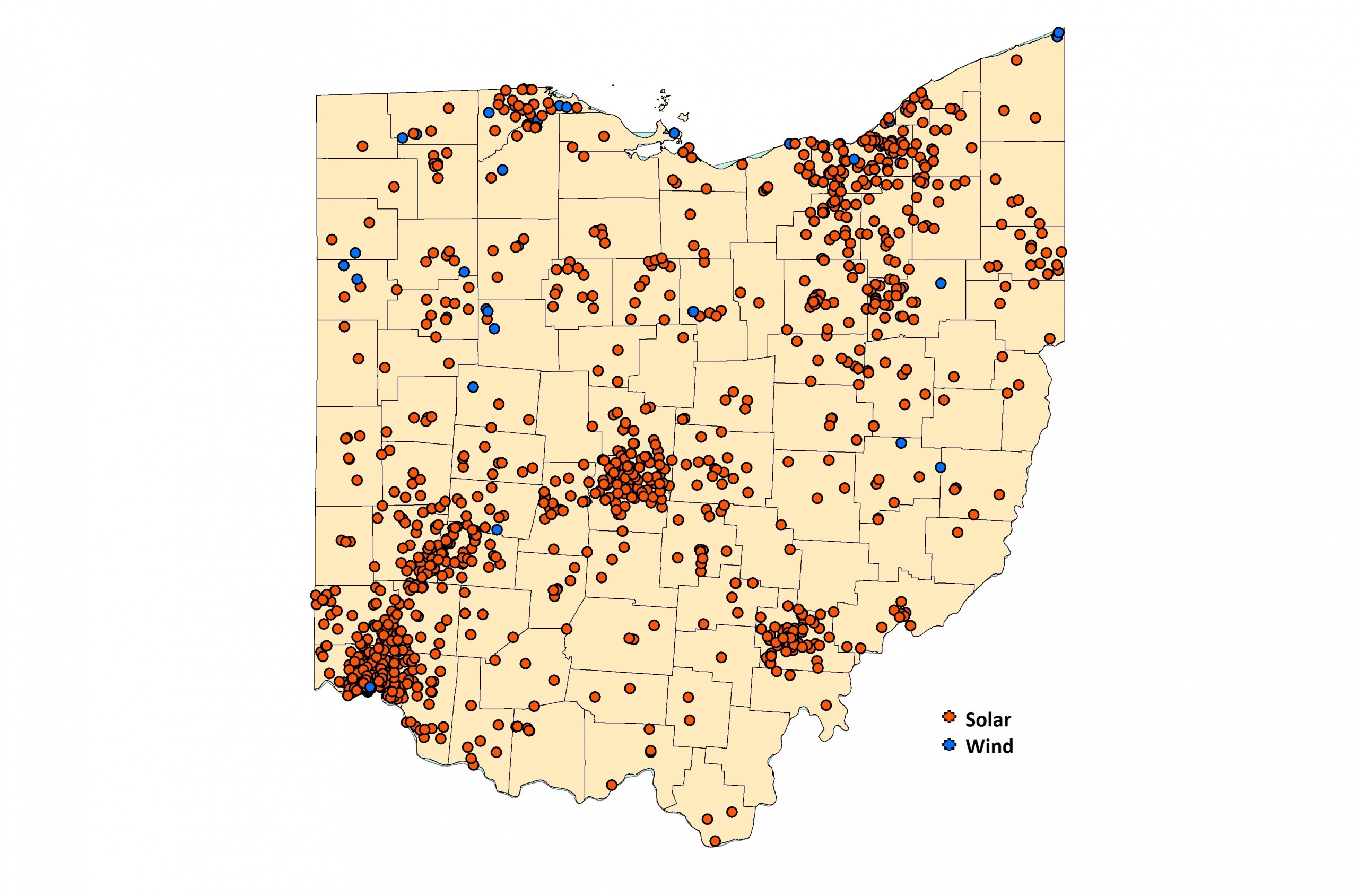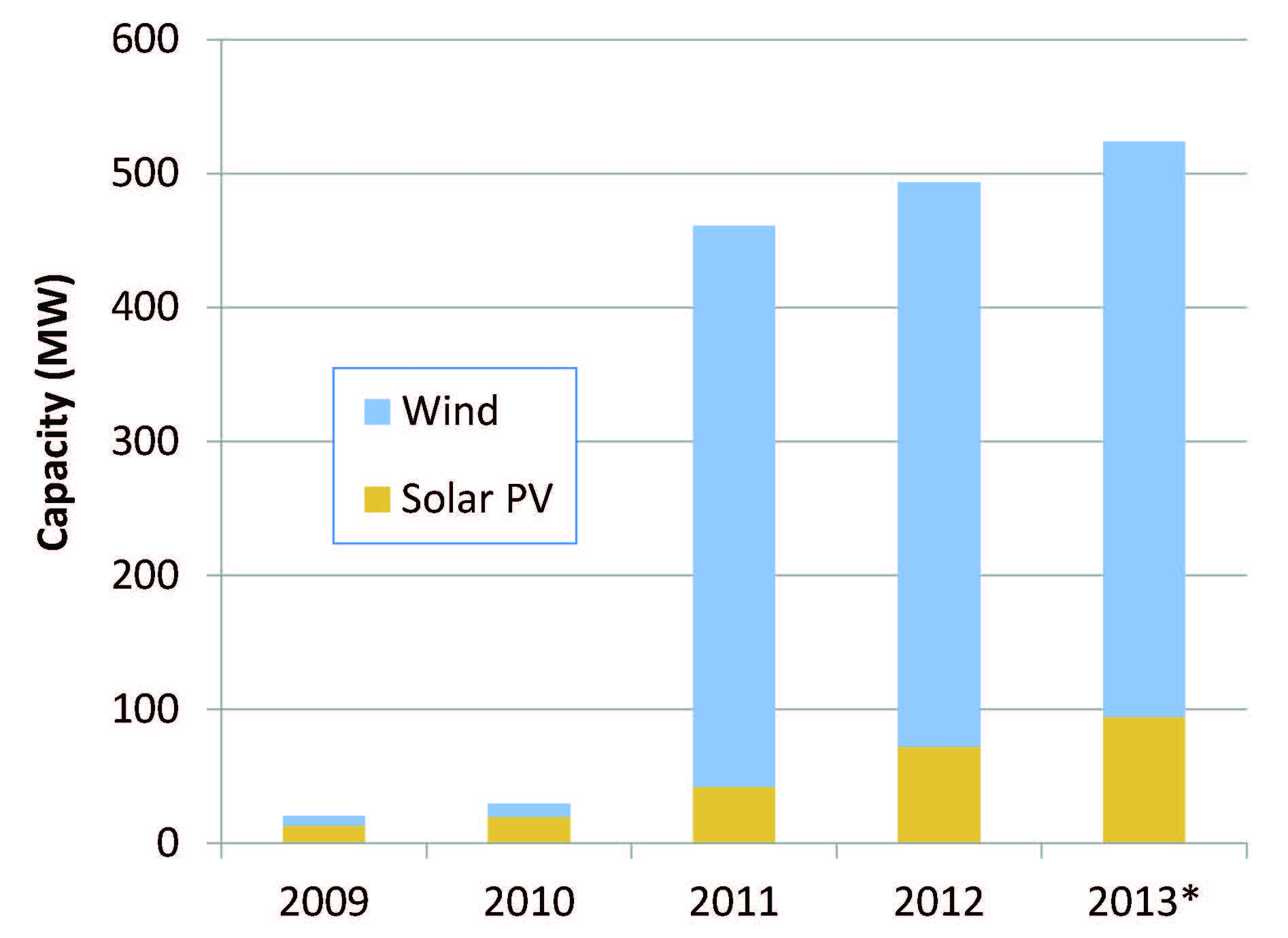Ohio’s Clean Energy Law is working – spurring wind and solar projects across the state and big investments in energy efficiency. The Clean Energy Law – Senate Bill 221 – was passed in 2008 and sets requirements for energy efficiency and renewable energy for each of the state’s four investor-owned utilities (IOUs). Ohioans across the state are benefiting from programs driven by the Clean Energy Law, which are reducing pollution, cutting our dependence on coal and gas, creating jobs, and saving money.
For the first time since the Clean Energy Law came into effect, FirstEnergy, Duke Energy, Dayton Power & Light (DP&L), and American Electric Power (AEP) all met the law’s energy efficiency, peak demand reduction and renewable energy requirements in 2012, delivering on the promise of clean energy for Ohio.
Thus far, Ohio’s Clean Energy Law has resulted in 5 million megawatt-hours (MWh) in cumulative energy savings, more power than all households in Cincinnati, Cleveland and Dayton combined use in a year, and has reduced peak electricity demand by 1,583 megawatts (MW) – equivalent to the capacity of Ohio’s sixth-largest power plant. In addition, 313 MW of wind power and 25 MW of solar energy were added in 2012, which could produce more power than every household in the city of Dayton uses in a year.
The Clean Energy Law has led to the launch of creative programs to update old technologies with new energy-saving devices, set Ohioans up for long-term energy savings, and helped Ohio transition away from its reliance on dirty energy sources to a clean energy economy.
This report highlights the most creative and effective examples of Clean Energy Law programs in a variety of categories. The success of these programs demonstrates the value of the Clean Energy Law to Ohio’s environment and consumers.
- Solid return on investment – Clean Energy Law programs such as DP&L’s Lighting Program deliver substantial energy savings at a low cost. By distributing more than 1.7 million high-efficiency lighting fixtures, this program saved more power than 6,800 Ohio homes use in a year at a cost of 3.8 cents per kilowatt-hour (kWh) saved – one-third the retail cost of electricity.
- Lasting savings – The Clean Energy Law is driving investments in energy efficiency that will benefit Ohioans for decades to come. Homebuyers in the service territory of AEP are saving energy in the long term with the utility’s New Homes Program, which gives builders incentives to upgrade and certify new single-family homes to meet Energy Star efficiency benchmarks. Ohioans living in the 796 Energy Star homes built under this program in 2012 will save over 100,000 MWh of electricity over the next 25 years – more than the amount of electricity an additional 650 Energy Star homes would use during that time period.
- Tapping Ohio’s renewable energy potential – By setting renewable energy standards for utilities, the Clean Energy Law is driving the development of wind and solar energy across the state. In 2012, for example, Ohio added the 304 MW Blue Creek Wind Farm, in part because FirstEnergy agreed to purchase renewable energy credits from the project in order to meet their renewable energy requirements. Solar energy installations also proliferated, including a 1,716-panel solar array on the roof of Kent State University’s Field House that generates 500 MWh each year for the university.
Figure ES-1: Map of PUCO-Certified Wind and Solar Energy Facilities in Ohio, as of October 2013
(Click on Figure ES-1 to see the growth of certified renewable energy facilities in Ohio)
Figure ES-2: Cumulative Capacity of Certified Solar and Wind Power Facilities in Ohio (shown by date the facility was approved by the PUCO)
*As of October 18, 2013.
- Saving energy at home – Residential consumers have benefited from Clean Energy Law programs such as utilities’ appliance recycling programs, which offer financial incentives to unplug and recycle old energy-inefficient appliances. The program improves with each year of the Clean Energy Law – more appliances were recycled in 2012 than in any previous year, and, with Duke Energy joining in October 2012, the program is now available to all Ohio investor-owned utility customers. In 2012, the programs recycled a total of 21,899 inefficient refrigerators, 5,698 freezers, and 823 room air conditioners to save a combined 28,791 MWh of energy – equivalent to the amount of power used by 2,419 Ohio homes in a year.
- Teaching the next generation to save – The Clean Energy Law has made energy efficiency part of the classroom. The Ohio Energy Project (OEP) has partnered with AEP and DP&L to teach kids about the fundamentals of energy efficiency and conservation, empowering them to apply what they’ve learned when they return home. AEP and DP&L partnered with natural gas companies in their service territories to train 524 teachers and distribute 40,924 energy efficiency kits to students – saving the amount of power used by 1,300 Ohio homes in a year.
- Helping Ohio businesses save – The Clean Energy Law is making it easy for businesses to save money and energy by replacing outdated, power-sapping equipment with modern, energy-efficient equivalents. DP&L’s “Rapid Rebates” Program was particularly effective – in 2012, DP&L incentivized 1,269 energy efficiency projects for businesses across the state, saving the amount of power used by 5,655 homes in a year.
- Retrofitting large institutions – Large institutions like hospitals use hundreds of times as much energy per year as the average Ohio home, and Clean Energy Law programs targeting those institutions are delivering big savings. AEP’s Prescriptive Business Program saved a verified 132,132 MWh of electricity for businesses and institutions across the state in 2012 by providing incentives that reduce the up-front costs of pre-approved energy efficient equipment. Over the past three years, 35 hospitals actively participating in AEP’s business programs have saved more than 40,000 MWh of electricity.
- Helping homeowners and businesses to implement renewable energy – Powering Ohio residences and businesses with small solar and wind energy systems presents a significant opportunity to boost Ohio’s clean energy production. To help Ohio homeowners and businesses owners overcome the upfront costs of installation, AEP’s Renewable Energy Technology Program provided incentives for 166 small renewable energy installations between July 2011 and June 2013, helping AEP fulfill its renewable energy requirements.
Public officials should ensure that Ohio continues to tap its abundant potential for renewable energy and energy efficiency by maintaining the Clean Energy Law and providing better oversight of utilities’ compliance.
- The Public Utilities Commission of Ohio (PUCO) should ensure that utilities are not overstating energy efficiency program savings and are adopting programs that will encourage new savings with long-term benefits. The PUCO should not credit utilities for energy efficiency savings generated in the past by customers without utilities’ involvement.
- The PUCO should facilitate utilities’ signing of long-term contracts for renewable energy. Unlike year-to-year markets for renewable energy credits, long-term contracts provide renewable energy developers with certainty about returns on their investment over time. The more renewable energy projects in Ohio, the greater the potential for added jobs and economic investment and the less we rely on polluting fossil-fueled energy sources. The PUCO should support long-term projects that offer significant environmental and economic benefits to Ohio, such as AEP’s 49 MW Turning Point Solar Project (which was denied approval by the PUCO in January 2013).
- Ohio should strengthen the renewable energy requirements of the Clean Energy Law to prompt further development of Ohio’s renewable energy resources, cut pollution and spur growth. In order to continue driving the increase in renewable energy installations in Ohio, the law should require Ohio’s IOUs to get 25 percent of their energy from renewable sources by 2025, including 3 percent from solar energy.
- The PUCO should require utilities to present information about their plans and compliance with Ohio’s Clean Energy Law in a clear and standardized fashion and the PUCO should issue its own rigorous review of the utilities’ filings each year.
- In order to achieve the full benefits of clean energy, the Ohio EPA should develop a robust State Implementation Plan to meet upcoming U.S. EPA standards limiting global warming pollution from power plants. Ohio is in a strong position to meet these standards through existing policies, including by fulfilling the standards of its Clean Energy Law.


